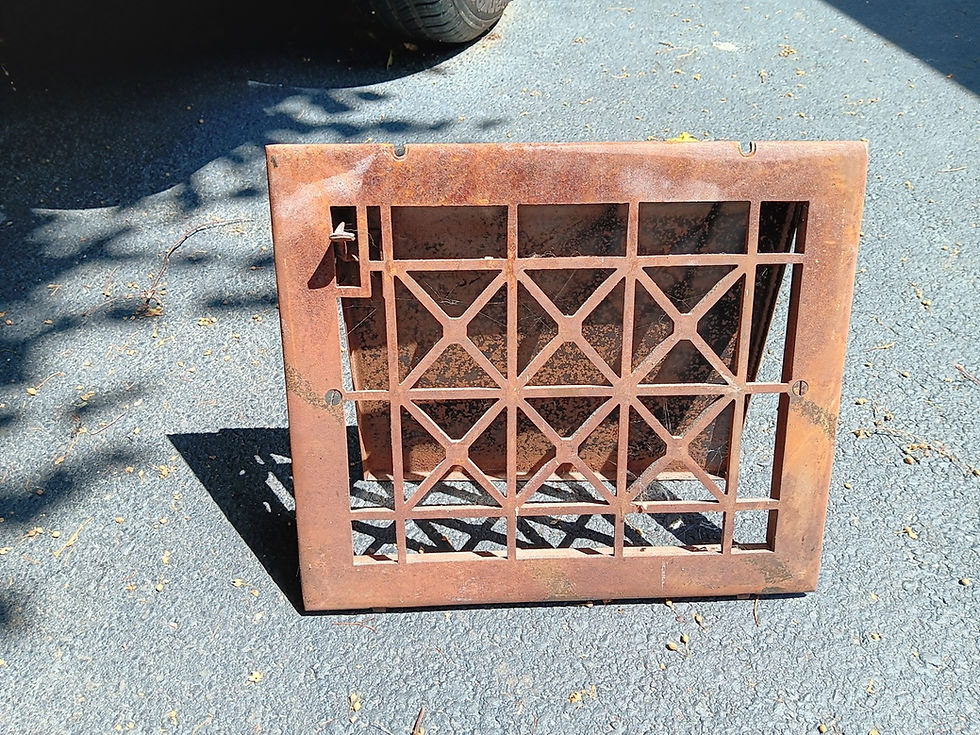Ideas from Ed: Ceiling light done right (Volume 5, issue 4)
- edwardpetrus

- Mar 31, 2022
- 4 min read
This month’s work was actually pretty simple, but the article may seem a bit over-detailed, because I tried to show a lot of the little steps in pictures. Bear with me, please!
This old ceiling light was calling out to me for attention:

Lights like this were always hard-wired and controlled by a wall-mounted switch, but usually did have (as this one does) a rotary knob that can also turn each fixture on/off (assuming the wall switch is ON). Most also had bell-shaped fixtures around the sockets, and this one probably did at one time. Those bells (and one whole socket) are missing now. Here is a picture of a different light, showing that type of bell that probably belongs on this ceiling light:

I didn’t have any bells like that in my stash of old stuff. I do have the option of installing circular brass rings like this one, above the sockets, so that glass shades can be retained on each. For now, I chose to just work on the main fixture, and I know that I can always add something like this in the future.

I did notice, however, that the very end of the one socket is threaded, so perhaps that had something to do with things originally. In any case, I went to my trusty drawer of electrical paraphernalia, and these are the only sockets that had twist-knobs instead of push-switches. The original is at the bottom:

You’ll note that the original has a flat switch knob while all my others have round ones. You can also see that of the set, I have two with the threaded socket ends. I reasoned that I could “mix and match” parts to come up with two sockets that look reasonably alike.
For the REAL do-it-yourself neophyte, getting the sockets apart is a serious task. New ones give you a clue as to how to do it, by having “PRESS” stamped onto the side. By pressing (hard) at that spot and wiggling and jiggling, the socket can be disassembled.

The old socket had porcelain guts. While it probably still worked, and might last another 100 years, I like to use new electrical parts when I can. It just seems like the safest thing to do.

If you’re working on something like this, you’ll need to decide what you want the end-product to actually look like. Having it re-plated in new brass is fine if you want that “new” appearance. You can also paint it or just try to clean it up a bit. Many fixtures, and this one, are typically made of stamped steel, brass plated. If only a light buffing is needed, it will look pretty good. However, more aggressive buffing, perhaps to remove deeper scratches, will take you through the brass coating and down to raw steel. That usually won’t be a pretty finish. In this case, I decided to make it look a bit nicer but still have that “antique old” look to it. This would be done using a metallic spray paint that imparts a bit of color with each coat. The final shade is determined by how many coats are applied. Here’s what I used. Remember, I don’t endorse any particular brands or products in my columns:

After spraying each coat (outside, in 20-degree weather) I hung the light in front of my furnace’s basement duct outlet for a quick-dry effect. Screwing the light onto a block of wood, and then driving a long screw into the block, gave me something to hold onto while spraying.

For the wiring itself, I went to my “wire box” and looked around. (If you don’t have such a thing, you should! Save cords from things being discarded so they can be used on other projects when needed.) Here’s my wire box:

They’d laugh at you in the hardware store if you wanted to buy just 2 or 3 feet of wire. It’s easier and often cheaper to just buy a light-duty extension cord from a “dollar” type store and cut an end off. The critical issues in my case were that I wanted the wire to be brown, and the wires had to be of small enough size that they’d fit through the ringlets in the light fixture. I found exactly what I needed in my box and cut enough to use.
Modern wires are usually stamped with SPT (stranded parallel thermoplastic), and one conductor has a smooth surface while the other has tiny ridges running along it. The smooth wire must always connect to the “bottom” of the socket where the base of the lightbulb will make contact, while the ridged wire connects to the socket body to contact the bulb threads. As far as electricity goes, things will work either way, but correct placement makes the “hot” side deep in the socket, which is safer from a finger-poking perspective. On modern electrical fittings, the socket base (the hot side) is a brass screw, while the “common” side is a silver screw.


After wiring each socket, the wires were then threaded up through the chains and joined together on the backside of the light, ready to be connected to house wiring.
The final appearance is just what was wanted – a vintage light that looks old but nice (..and is safely wired!)

I hope all your projects go well. Thanks for reading, and happy restoring!
Ed
If you’d like to download a PDF of this “Ideas” column, click here:




Comments